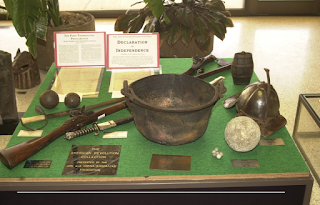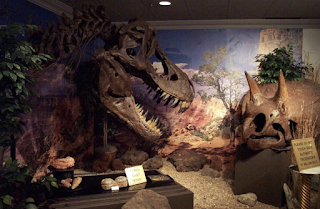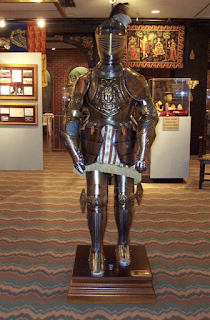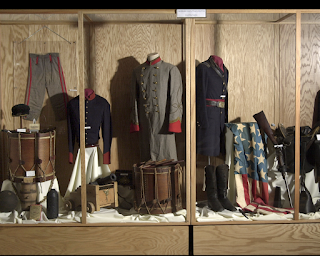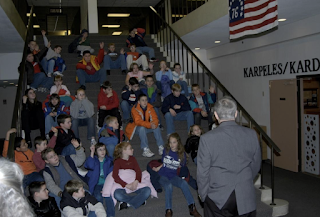History of the Museum Part 1
May 9, 2016
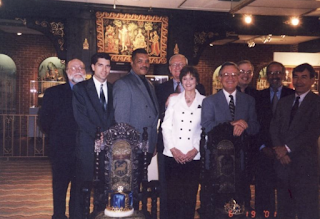
The Museum of World Treasures was founded on January 12, 2001. Even though it’s one of the youngest museums in Wichita, or Kansas, for that matter, the Museum of World Treasures, or MOWT for short, has gone through a lot of changes. It has been in two buildings, changed its name once, expanded from three halls to twenty-five exhibits, increased its collection from less than 3,000 to nearly 10,000 objects, and gone from a curiosity to the top rated museum in Wichita.
Despite these changes, some things have remained constant. It has always been focused on history and conducted school tours. Now, in its fifteenth year, MOWT is poised for some exciting changes, but to put the future in perspective, it is helpful to look back at MOWT’s origin and history.
The Beginnings of the Museum of World Treasures
The history of MOWT goes all the way back to when a young man went on vacation with his family. While in Jerusalem, the young man purchased a coin of Herod the Great. The coin fascinated him, and from that moment on, he began collecting more ancient coins. That boy’s name was Jon Kardatzke.
When Jon Kardatzke grew up, he became a medical doctor. He established a family medical practice where he worked for thirty-five years. During all this time, he still had a passion for collecting historic coins. As many collectors do, he followed auctions and looked through their catalogs, searching for new and interesting coins. One day, he saw a manuscript signed by President Thomas Jefferson. It interested him and his passion for collecting expanded from simply coins to include historic documents. Eventually, he was collecting all manner of ancient artifacts.
As Dr. Jon collected more and more artifacts, his basement became very crowded. Much of his home was filled with ancient artifacts and it wasn’t always appreciated by Dr. Jon’s wife, Lorna. She wished something could be done with them. On October 31, 1998, there was a downpour in Wichita and the creek behind their house swelled dramatically. They rushed to remove the artifacts from the basement. Just as the last artifacts were brought upstairs, the lower level doors burst open, flooding the basement where the artifacts had just been. Lorna told her husband it was time to do something with the artifacts.
By January, 2001, Dr. Jon was ready to found a museum. The Articles of Incorporation of the not-for-profit Museum of Ancient Treasures, Inc. were signed and notarized on January 12, 2001. The original three board members were: Dr. Jon Kardatzke, Leslie Donovan, and Marcia Parduhn-Burlie.
Not only did the Museum of Ancient Treasures ("MOAT") originate in January, 2001, the first exhibition of its artifacts occurred at this time as well. Starting in January and running until February, the Museum’s artifacts were displayed in the halls of Century II. While the majority of these artifacts came from Dr. Jon’s personal collection, there was another individual who contributed to the Museum’s collection. His name is David Karpeles.
Mr. Karpeles already had his own museum. Matter of fact, the Karpeles Manuscript Library, which is still in existence today, has a huge collection of original manuscripts and twelve locations spread across the country to display them. Back in 2001, Dr. Jon made an agreement with David Karpeles where he sent facsimiles of some of the historic manuscripts to Dr. Jon and Dr. Jon used them in the Museum.
|
|
|
Figure 4 |
As the name suggests, MOAT focused on ancient history. The notable displays included fossils; ancient artifacts from Mesopotamia, Egypt, Greece, and Rome; artifacts from Asia and Africa; and some artifacts that came from the early years of the United State’s history.
An example of one of the displays that appeared at Century II is shown in Figure 4. First, note the large black marbled sign at the front of the case. It says, “The American Revolution Collection Presented by the Jon and Lorna Kardatzke Foundation.” As is evident from the display in Figure 4, MOAT began as a collector’s gallery. Even though MOAT did not have a permanent home, Dr. Jon focused on using the Museum as an educational institution. At least one school, Lincoln Elementary, had a tour at MOAT while it was in Century II.
The Museum Finds a Permanent Home
The exhibition of MOAT at Century II continued from January through February. After that, the Museum moved into the basement of the Garvey Center. Acquiring a permanent home provided a huge benefit to the Museum but it also required a lot of work. A whole set of cases had to be built for the artifacts. In addition to finishing such paperwork and legal requirements, the Museum also had to organize the artifacts in its collection into thematic exhibits.
|
|
|
Figure 7 |
|
|
|
Figure 8 |
At the Garvey center, the focus of MOAT continued to be on ancient artifacts. The exhibits were divided into three galleries: the Hall of the Ancients, the Hall of Royalty, and the Hall of the Americas. The Hall of the Ancients was by far the largest part of the Museum and it encompassed the widest range of artifacts, including everything from fossils, to stone tools, to Egyptian, Greek, Persian, Roman, European, and Pre-Hispanic artifacts. Many of the artifacts seen in these exhibits should be familiar to those who visit the current MOWT, as many are still on display. The Museum’s Egyptian coffins can easily be seen in Figure 7, as can its large Roman marble statue and a variety of other artifacts. Two pieces that are of particular note are the Tyrannosaurus rex and Triceratops skulls, which can be seen in Figure 8. The Tyrannosaurus rex skull is a cast of Stan, a famous Tyrannosaurus rex whose skeleton is housed in the Black Hills Institute. This cast is currently displayed in the entryway of MOWT. The Triceratops skull, which is composed of real fossils, is currently on display in MOWT behind Ivan. Not surprisingly, these dinosaurs were a big hit: we have several photographs of students on tour posing next to Stan’s skull.
The Hall of Royalty and the Hall of the Americas had some artifacts, but they both had a large number of documents. The suit of armor seen in Figure 9 is a replica and it is currently on display by the stone arch overlooking the central stairwell. Behind the suit of armor, a few wall hangings containing documents signed by members of royal families, a case, and a few tapestries can be seen.
|
|
|
Figure 9 |
|
|
|
Figure 10 |
When MOAT was first founded, the entire collection of artifacts were those that belonged to Dr. Jon and those facsimiles provided by David Karpeles. The very first donation of artifacts to the Museum was made on July 9, 2001 when Rose McCoy donated nine photographs from World War II. She was the first of what would become over one hundred people who have donated objects to the Museum. In addition to accepting donations, the Museum also made loan agreements with other collectors. One such group of collectors was the Confederate Cavalry Preservation Trust. They had a display of Civil War artifacts in the Hall of the Americas, which can be seen in Figure 10. In addition to individual collectors, the Museum also borrowed objects from the American Overseas Schools Historical Society, or AOSHS. This organization, whose headquarters are in the Delano district of Wichita, has documents and a few artifacts that relate to American schools for the children of military families that were stationed overseas. While most of their collection is housed at their location, they have a few objects that are just too big for them to keep. In 2002, they loaned a suit of armor, named Clarence the Crusader, to MOAT. Clarence was made in the 1850’s but was a replica of the style of armor used in the 1400’s. In addition to being a terrific representation of a suit of armor, Clarence was also the mascot for the Bonn American High School in Germany from the 1950’s until the school closed in 1997.
|
|
|
Figure 12 |
In addition to the various exhibits and artifacts, MOAT had other things that you would expect at a museum. For one, it had a gift shop selling merchandise such as replicas and statues of ancient Egyptian pieces and coffee mugs with pictures of mummy masks on them. Second, it had a mission. The mission of MOAT was, “To foster education and understanding of the creativity, arts, religion, and culture of our amazing heritage from the ancients to the present.” To fulfill the purpose of educating, MOAT conducted tours of the Museum and its exhibits. A tour group preparing to enter the Museum can be seen in Figure 12.
There are a couple of things to note in Figure 12. First, note the name on the wall on the right. The full title cannot be seen, but it reads, “Karpeles/Kardatzke Manuscript Library.” David Karpeles’s contributions to the Museum were significant enough that his name was associated with Dr. Jon Kardatzke’s. Dr. Jon loved to talk about the artifacts and share his knowledge of history with people and it was something that he would continue to do for many years.
|
|
|
Figure 13 |
MOAT received some dignitaries during its time at the Garvey Center. Figure 13 shows the mayor of Wichita, Bob Knight, along with the City Council visiting MOAT. While they are not shown here, Representative Todd Tiahrt and his wife, Vicki, visited MOAT at the Garvey Center as well.
“This is the first of four blog entries from guest author Steven King. Stay tuned for the rest in the series."
